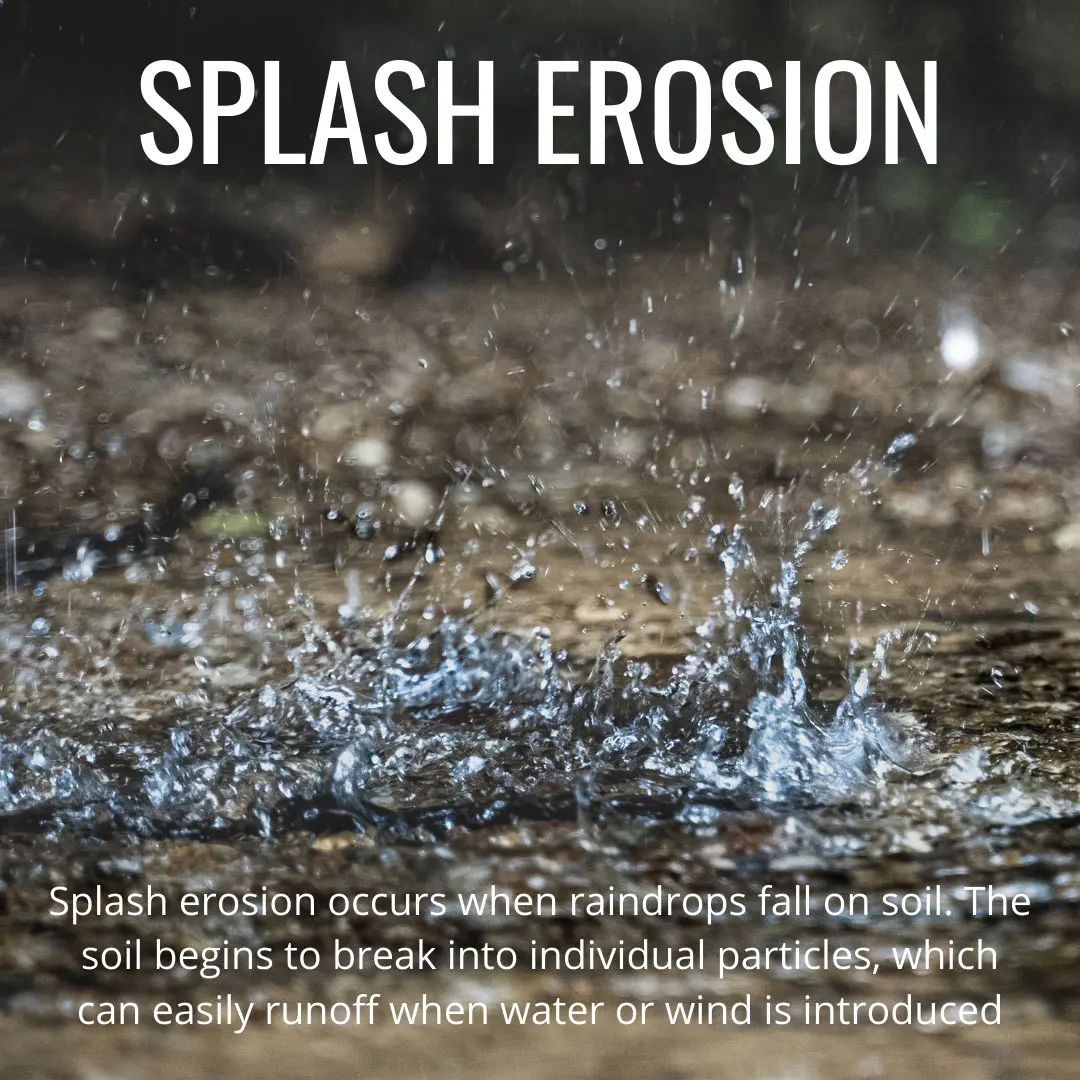Good, fertile soil and clean, healthy water are invaluable resources for agricultural producers. Soil erosion is a serious threat to both.
As WWF explains, erosion can disrupt the soil, sweeping away sediment and nutrients until it is no longer suitable for farming. Unfortunately, if that misplaced sediment becomes runoff, it can end up choking nearby waterways and lowering water quality.
Learning to recognize the six types of soil erosion can help you protect your livelihood and the natural resources that are essential to its success.
Splash Erosion
Splash erosion starts with a fall of rain, which might be why it’s sometimes called raindrop erosion. As Oklahoma State University explains, this type of erosion occurs when a raindrop hits the soil and dislodges particles of soil, splashing them up and away. Once freed, these particles are more vulnerable to being swept away by other forces.
This type of erosion is hard to detect. If you look closely after a hard rain, you might be able to spot places where small bits of soil have been splashed up onto various surfaces. When the disturbed soil simply falls back into place, there’s not much trouble. However, when wind or water carries the detached soil away, you’ll find yourself losing your topsoil if you don’t take action.

Sheet Erosion
If rainwater begins to move the soil that’s been loosened by splash erosion, the erosion of the soil progresses to a new stage. It’s now called sheet erosion. A heavy rain or runoff that crosses a shallow surface can allow enough water to gather to pull the loosened soil particles from surfaces and sweep them away.
As Iowa State University reports, sheet erosion is practically invisible. Light-colored soil is often a clue that years of rain-driven runoff may have been eroding valuable topsoil.


Rill Erosion
Picture a sandbox after a child has trailed their fingertips through it. While the scale tends to be a bit bigger than that, and it only expands with more time and water, that’s the basic effect that rill erosion has on the land.
This form of erosion leaves the ground marked with parallel lines of small, clear-cut channels. The rills are generally no more than 30 cm deep, according to Safeopedia.
As water continues to move through these lines, it begins to erode the surrounding soil. Shallow rills can generally be removed by tilling, but if they’re allowed to progress, they can form gullies.

Gully Erosion
If rills aren’t tended to, the erosion will continue. Eventually, the narrow strips of land separating the multitude of rills will be swept away, leaving one larger scar behind. Once again, the erosion has evolved to a new stage. A gully is a channel that is too deep to be eradicated with normal tillage methods.
Gully erosion can carve fierce scars across fields. As Oklahoma State University indicates, some gullies reach depths of 20 feet. These features can create real hazards for livestock and farmers. If awkwardly located, they may make sections of fields inefficient to farm or outright unusable.

Wind Erosion
While pictures of tumbleweeds and windstorms are often associated with the American West, the reality is that wind erosion can steal valuable topsoil from any location where the soil is dry, bare, and unprotected by vegetation. According to the University of Nebraska-Lincoln, it’s particularly problematic under certain conditions:
- The soil is fine, loose, and dry.
- There are large fields with no obstacles to block the wind.
- The wind is strong enough to move the soil.

Floodplain Erosion
The areas along waterways are often incredibly fertile. They also offer easy access to water for irrigation and may even provide a way to transport goods to market. With the benefits they offer, it’s no wonder that agricultural operations have often settled alongside waterways whenever possible. However, there is a danger lurking: floodplain erosion.
Flooding can do a lot of damage. Floodplain erosion may not be the kind that makes headlines, but it is a very real concern for those who count on quality soil for their livelihoods.
According to Home Stratosphere, rushing flood waters can strip off 0.1m to 0.15m of topsoil. Basically, an entire layer of soil is snatched away in an instant. Meanwhile, the remaining subsoils are left vulnerable to further erosion.

Protecting Your Topsoil From Many Types of Soil Erosion
Erosion is a natural force, but it isn’t inevitable. As The Natural Resources Defense Council reports, there are steps that landowners can take to counteract its corrosive efforts and protect the soil:
- Plant vegetation. Bare soil is at risk, so consider using cover crops to provide uninterrupted ground cover and bind and nourish the soil. Trees, hedgerows, and other plants cultivated as wind blocks can also be helpful.
- Utilize no-till or minimal tillage practices. Research suggests that no-till and minimal-tillage practices offer significant benefits. Leaving the soil undisturbed helps it hold onto greater quantities of vital nutrients like nitrogen. It can also decrease both erosion and runoff, which boosts water quality and crop productivity.
- Build soil organic matter. Soil organic matter helps to keep soil anchored. Increasing the amount in the mix can not only reduce erosion but also improve water-holding capacity.
- Be mindful when selecting grazing practices. Implementing rotational grazing and other mindful practices can limit soil compaction and erosion.
Soil erosion is an ongoing battle between various forces. On one side, you have the wind and water that would steal the soil particles away. On the other, you have gravity and the proactive efforts of people who want to protect a valuable natural resource. While it may take a little thought and energy, those efforts can make a real difference.

